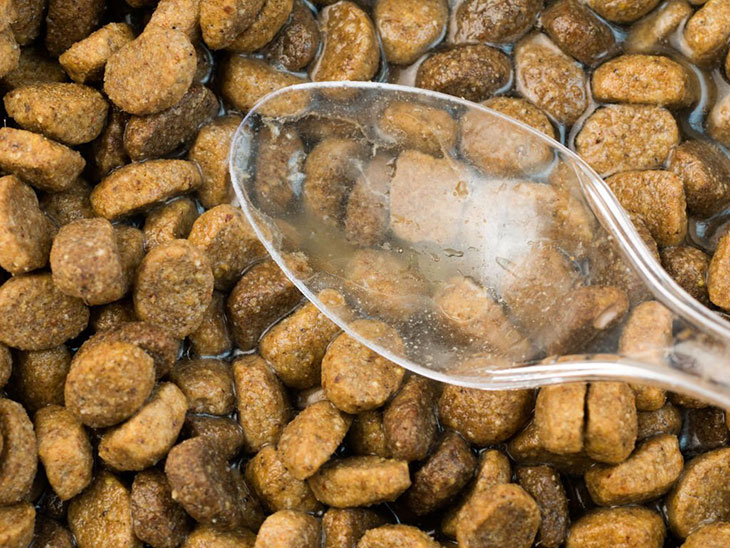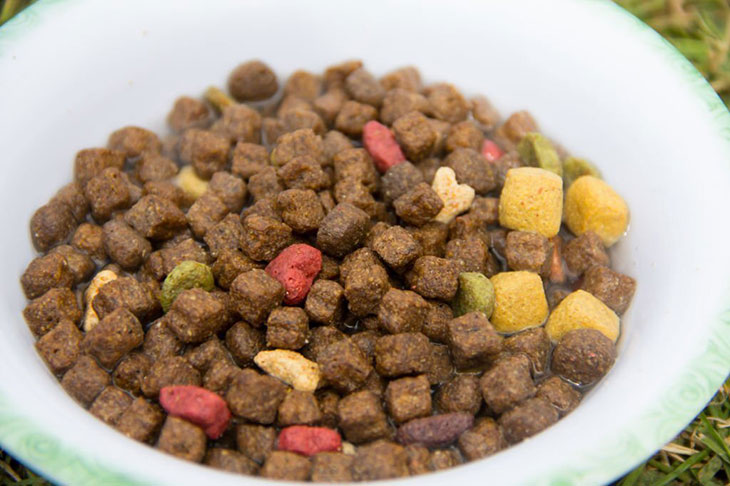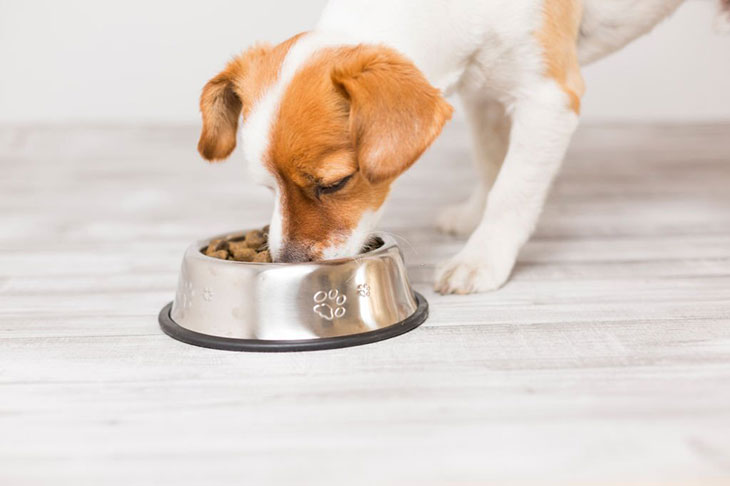Many pet owners think about adding water to dry dog food to make eating more fun and easier.
When they make dry kibble a bit wet, it’s like finding a middle ground between the good things and the things we need to be careful about.
It’s best to learn about the pros, cons, and tips to add water to dry dog food without affecting its quality and nutrients.
This can help us better understand our dogs’ eating routine and ensure that our furry friends have the best mealtime ever.
Let’s take a closer look at why people do this and what we should consider.
What Are The Pros And Cons Of Adding Water To Dry Dog Food?

Mixing dry dog foods with water can stimulate appetite, support digestion/oral health/urinary health, and aid in weight management and hydration.
But it costs more time, increases the risk of food wasting and spoiling, and entails some health issues for your dogs.
Pros
Appetite Stimulation
When you add warm water to dry kibble, it helps release the meaty aromas from the food. It intensifies the smell, making the food more enticing to your dog.
Dogs have a strong sense of smell, and a more aromatic meal is likely to pique their interest and stimulate their appetite.
Dogs recovering from illnesses or surgeries, or those with a general loss of appetite, might benefit from softened kibble.
The improved taste can encourage these dogs to eat, which is crucial for their recovery and overall well-being.
Aids In Digestion
Dry dog food can puff up in the stomach, making your dog uncomfortable and sometimes causing them to throw up.
Soaking the food in water before giving it to your dog can stop this swelling and reduce their chances of feeling sick.
The water in the food helps it move through your dog’s tummy and intestines without any trouble.
Besides, adding water to dry food makes it softer and easier for your dog’s stomach to handle.
It means the tummy doesn’t have to work as hard to break down the food. It’s especially good for an old, baby dog, or dog with a sensitive tummy.
When the dry food gets wet, the good things inside it (like vitamins and nutrients) are easier for your dog’s tummy to grab.
Thus, your dog’s body can use these good things better.
Assists Oral Health Issues
Dogs with dental issues might have a tough time chewing hard, dry food. By adding water to their food, it becomes softer and less crunchy.
It makes it easier for dogs with sore teeth or gums to chew without pain.
Small dog breeds and older dogs are more prone to dental issues due to their size and age.
Adding water to their food is especially beneficial for dogs, as it helps them continue eating comfortably even with oral health challenges.
Hydration Support
Some dogs don’t drink enough water alone, leading to issues like lethargy and dehydration.
You’re essentially “hiding” hydration within their meals by soaking their food. This can be especially helpful for dogs that don’t drink as much as they should.
Proper hydration is essential for all of the body’s functions. Water is needed for cells, organs, and tissues to work well.
If a dog doesn’t have enough water, it might become tired and sluggish.
Moreover, when it’s hot outside, dogs might not drink enough water to stay properly hydrated.
Soaked kibble can provide extra water intake, crucial in preventing dehydration, especially in warm weather.
Gulping Prevention
Dry kibble doesn’t break down as easily as moistened food. When dogs eat too quickly, they might not chew their food properly, leading to larger pieces entering the stomach.
Adding water helps the kibble break down before it’s even eaten, making it easy to swallow.
Some dogs are particularly prone to gulping. Some owners use slow feeders and add water to dog food to make dogs work to get their food, slowing down their consumption and promoting better digestion.
Weight Management
Adding water to their food can help increase the physical volume of their meals, making them feel fuller even though they’re consuming fewer calories.
It can help prevent your dog from needing to eat more after their meal.
Dogs on a weight loss journey might be tempted to search for extra food around the house if they don’t feel satisfied after their meal.
Adding water to dog kibble can help prevent this behavior by making them feel more content and full.
Urinary Health
Too much moisture in a dog’s food can help prevent the formation of kidney stones and lower the chances of urinary tract infections.
When the urine is more diluted due to high water intake, minerals are less likely to crystallize and form stones.
Additionally, well-hydrated urinary tracts are less prone to infections.
Dog’s urinary systems rely on water to move waste efficiently through the system.
Enough water in the system can flush out toxins and waste products easily, promoting overall urinary tract health.
Cost-Effective Option
Dry dog food is less expensive per pound than canned or raw food due to its reduced moisture content.
Mixing dog food with water increases its moisture content without the higher cost associated with wet or raw food.
Over time, the cost difference between dry kibble and wet or raw food can add up, especially if you have a larger dog or multiple dogs.
By choosing to add water to kibble, you’re providing the benefits of increased moisture without the additional expense.
Bloat Prevention
Adding water to kibble can help stop a dangerous problem called bloating. Bloating in dogs can happen if they eat too quickly, especially in big dogs.
When they eat too fast, they swallow air, and their tummy gets big,
Adding water to the dry food slows down eating. It makes the food softer, so dogs have to chew more and eat slower.
It means they swallow less air, and their tummy is less likely to get too big.
Cons
Teeth-Cleaning Issue
While dry kibble might have a texture that suggests it could help clean teeth, it’s not effective as many people think. Dry kibble has stuff that turns into sugars.
These sugars can stick to teeth and make plaque. It means even if dogs chew kibble, it might not really help their teeth.
Besides, crunching kibble might clean teeth a bit, but adding water softens it, taking away this benefit.
Extended Meal Prep Time
While soaking kibble has its perks, it can also be less convenient, especially for busy people or those who prefer a quick feeding process.
It is because you have to wait for about 1 to 5 minutes for the food to soften before giving it to your dog.
This period may not seem significant, but it does add up over time, particularly if you are always in a rush.
Thus, whether or not to soak dry kibble depends on your dog’s specific needs and your lifestyle.
If you find that the benefits of soaking outweigh the extended prep time, it might be a worthwhile practice for you and your dog.
On the other hand, if convenience is your priority and your dog does well with dry kibble, you might skip the soaking step.
Risk Of Food Waste
Moistening dry dog food can shorten its shelf life. When water is introduced, the food becomes softer and more prone to spoilage over time.
It means that the food may not stay fresh for as long as it would in its dry state.
Besides, the soaked kibble should be consumed within 24 hours. If your dog doesn’t eat it within that time frame, you’ll need to discard it, which can result in wasting uneaten food.
Water Intoxication Hazard
Water intoxication, also known as hyponatremia, can occur when a dog consumes too much water in a short period.
Adding excessive water to dry dog food can result in your dog taking in a large amount of water along with the food.
It disrupts the balance of electrolytes (important minerals) in the body, affecting normal bodily functions.
An electrolyte imbalance stem from excessive water consumption can lead to a disturbance in brain function.
It can affect coordination, trigger lethargy, and even more severe symptoms like vomiting, dilated pupils, and excessive salivation.
Possibility Of Rejection
Dogs can be choosy eaters when it comes to the texture of their food. Some dogs might not like the wet and soggy texture that moistened kibble can create.
Moistened food should be eaten promptly. It can become a haven for bacteria to thrive if you let it sit out for an extended time, especially in warm conditions.
Your dog might not want to eat it later due to the changed smell or taste.
If your dog doesn’t enjoy wet kibble, try using less water or serving the moistened food quickly. This way, the kibble won’t become too soft and unappetizing.
Hard To Get The Right Proportions
The amount of water needed to achieve the desired texture can vary based on factors like the type of kibble, its size, and your dog’s preferences.
This makes it tricky to get the perfect texture every time consistently.
Figuring out the right water volume your dog prefers might involve trial and error. Too much water can make the food soggy, while too little might not soften it enough.
Risk Of Health Problems
Much like humans facing weight gain and dental issues from excessive consumption of carbs and junk food, dogs can encounter similar concerns when consuming kibble high in carbohydrates.
Adding water to kibble introduces another layer of complexity.
When moistened kibble is left untouched for extended periods, it can become a breeding ground for harmful bacteria, leading to digestive discomfort and other tummy-related issues for your dog.
Furthermore, the addition of water could potentially dilute the nutritional density of the kibble.
The essential nutrients that provide your dog with the necessary vitamins, minerals, and proteins might become more dispersed due to the hydration process.
This dispersion could undermine the intended nutritional balance, raising concerns about whether your dog is receiving all the vital elements they require for optimal health.
Storage Problems
If you moisten your dog’s food, any leftovers should be stored in the refrigerator to prevent bacterial growth.
It takes up space and requires extra care to ensure the food stays safe to eat.
Storing already-moistened kibble can be more cumbersome than having dry kibble on hand, especially when traveling or during outdoor activities.
Steps And Tips To Add Water To Dry Dog Food

Steps To Add Water To Dog Food
- Measure kibble: Get your dog’s regular dry food and measure the right amount for their meal.
- Add water: Start with a little water in a clean bowl. About ¼ to ½ cup water for each cup of kibble is a common guide.
- Mix: Gently stir the water and kibble together until the kibble is damp but not too wet.
- Wait: Let it sit for around 5 minutes to let the kibble soak up the water.
- Serve: Put the moistened food in your dog’s bowl.
- Watch: Observe how your dog reacts to the moistened food.
- Eat promptly: If your dog doesn’t eat within 20-30 minutes, remove the meal to avoid the dog food going bad.
- Clean up: Wash the bowl after your dog’s done eating.
Tips To Remember
Use Clean Water
Always use fresh, clean water you give your dog for drinking to ensure your dog’s safety.
Avoid using water that might have contaminants or additives that could affect your dog’s health.
Add Less Water First
Start by adding little water to the dry food. It allows you to see how your dog reacts to the change in texture and taste.
Adding a little water prevents making the food overly wet, which might deter your dog from eating it.
Avoid Adding Hot Water
Never use hot water when moistening your dog’s food. Hot water can burn your dog’s mouth, bringing discomfort and potential injury.
High temperatures can also affect the nutrients in food, making it less nutritious for your dog.
Adjust The Texture
Mix the water and dry food to achieve the right texture that your dog enjoys. Start by creating a thicker mixture resembling a paste, then adjust based on your dog’s preference.
Some dogs like it slightly moist, while others prefer a drier texture.
What Are Some Alternatives To Water?

Broths
Bone broth: This is a nutritious and flavorful option. Simmering bones and connective tissues create a liquid that is packed with nutrients.
Bone broth is tasty and rich in things like glucosamine, which helps keep your dog’s joints healthy. It can also support their gut and immune system.
Homemade broth: You can make your own broth by boiling chicken, meat, or veggies.
It makes the food more interesting and does not add extra things like onion, garlic, or salt, which are bad for dogs.
Goat’s Milk
Goat’s milk is a safer alternative to cow’s milk due to its lower lactose content. It has less content that can upset your dog’s stomach.
Goat’s milk is also a good source of probiotics that can improve your dog’s digestion and health.
However, ensuring that your dog has no allergies or sensitivities to dairy is important.
Dog Hydration/Electrolytes Drink
Sometimes dogs can get really thirsty or have tummy trouble. Just like how people drink special drinks when they’re sick, there are drinks for dogs too.
These drinks have special content called electrolytes that help fix the balance of liquids in your dog’s body.
Therefore, if your dog is feeling sick or extra thirsty, these drinks can help them feel better.
FAQs
Can Adding Water To Dry Dog Food Cause Bloat?
No. Mixing water with dry dog food can help lower the chance of a serious stomach problem called bloat.
Bloat can happen with any kind of food, but when you put water in the food before your dog eats it, it’s likely to puff up in its stomach.
Also, it’s important not to let your dog drink too much water right after eating, eat too quickly, or run around a lot right after a meal.
How Long Should Dry Food Be Soaked?
Soaking puppy food often takes around 10-15 minutes. It helps the food become softer, which is important for young puppies because their teeth are still growing and developing.
If you use hot water to soak the food, wait until it cools down before giving it to your puppy. This cooling down might take more than the usual 10-15 minutes.
It’s all about ensuring the food is safe and comfortable for your puppy.
Will Adding Water Affect The Nutritional Value Of The Food?
Adding a little water to your dog’s dry food usually won’t change its good stuff, like vitamins and protein.
But don’t add too much water or the good stuff might get spread out. If you’re not feeding it all right away, put the wet food in the fridge.
If you’re unsure, ask your vet.
Mixing the food with a bit of water can help your dog eat better, especially if they’re young or have trouble with their teeth. Just don’t use too much liquid!
Conclusion
In short, adding water to dry dog food presents a choice between nutrition and convenience.
While the hydration and softening of kibble offer benefits such as improved digestion, dental health, and increased water intake, the process extends meal prep time and may cause some health problems.
Therefore, it’s best to find out your dogs’ preferences and condition and ask for advice from a veterinarian to know how much water you should add to your dry meal for your puppies.
